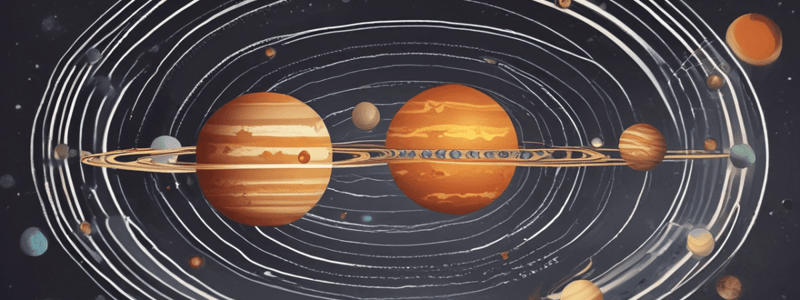Podcast
Questions and Answers
What is the main object in our solar system?
What is the main object in our solar system?
- Pluto
- The Moon
- The Sun (correct)
- The Earth
What force keeps planets, asteroids, and comets in orbit around the sun?
What force keeps planets, asteroids, and comets in orbit around the sun?
- Magnetism
- Gravity (correct)
- Wind
- Electricity
When was our solar system formed?
When was our solar system formed?
- 2 million years ago
- 4.6 billion years ago (correct)
- 100 million years ago
- 10,000 years ago
What is NOT part of our solar system?
What is NOT part of our solar system?
What are the objects held in orbit around the sun called?
What are the objects held in orbit around the sun called?
What is the main force that holds objects like planets, asteroids, and comets in orbit around the sun?
What is the main force that holds objects like planets, asteroids, and comets in orbit around the sun?
Which of the following statements is true about stars compared to planets?
Which of the following statements is true about stars compared to planets?
What differentiates stars from planets in terms of their size and light production?
What differentiates stars from planets in terms of their size and light production?
What classification does the sun have among the types of stars present in our solar system?
What classification does the sun have among the types of stars present in our solar system?
How old is our solar system believed to be based on the provided information?
How old is our solar system believed to be based on the provided information?
What is the percentage of the solar system's mass that the sun comprises?
What is the percentage of the solar system's mass that the sun comprises?
Flashcards are hidden until you start studying
Study Notes
Solar System Overview
- The Sun is the central object in our solar system, providing light and heat essential for life on Earth.
- The gravitational force from the Sun keeps planets, asteroids, and comets in orbit, allowing stable motion in space.
- The solar system was formed approximately 4.6 billion years ago, marking a significant event in cosmic history.
Solar System Composition
- Objects not part of our solar system include stars that reside outside the influence of the Sun’s gravity.
- The term "solar system objects" refers to all celestial bodies bound by the Sun’s gravity, including planets, moons, asteroids, and comets.
Stellar Comparison
- Stars, unlike planets, generate their light through nuclear fusion, making them luminous and hot.
- Planets do not produce their light; they reflect the light of stars, appearing less bright.
Star Classification
- The Sun is classified as a G-type main-sequence star (G dwarf), indicating its size, temperature, and energy production characteristics.
Solar System Mass Distribution
- The Sun comprises about 99.86% of the total mass of the solar system, making it the primary gravitational anchor for all other celestial bodies.
Studying That Suits You
Use AI to generate personalized quizzes and flashcards to suit your learning preferences.




